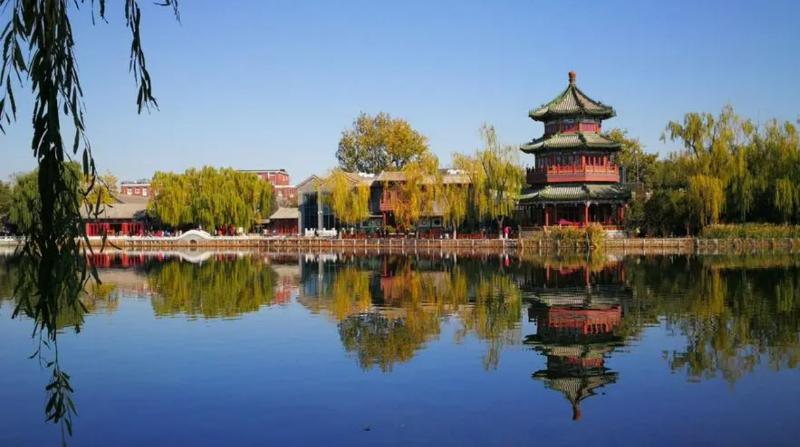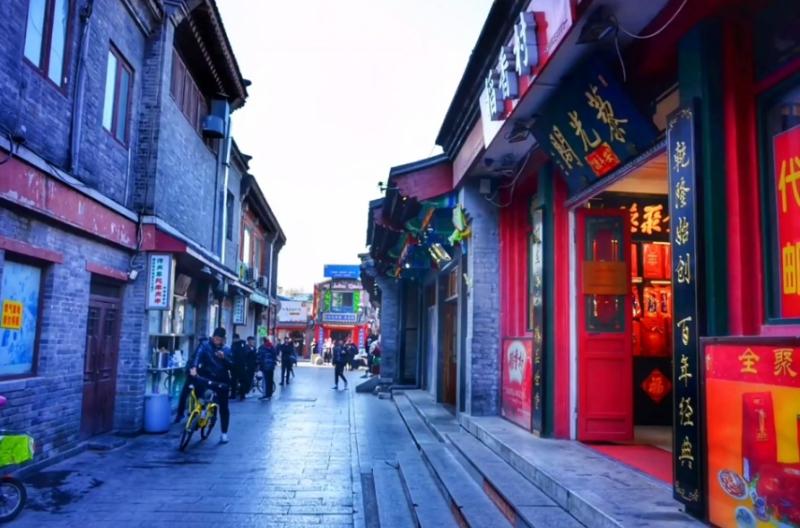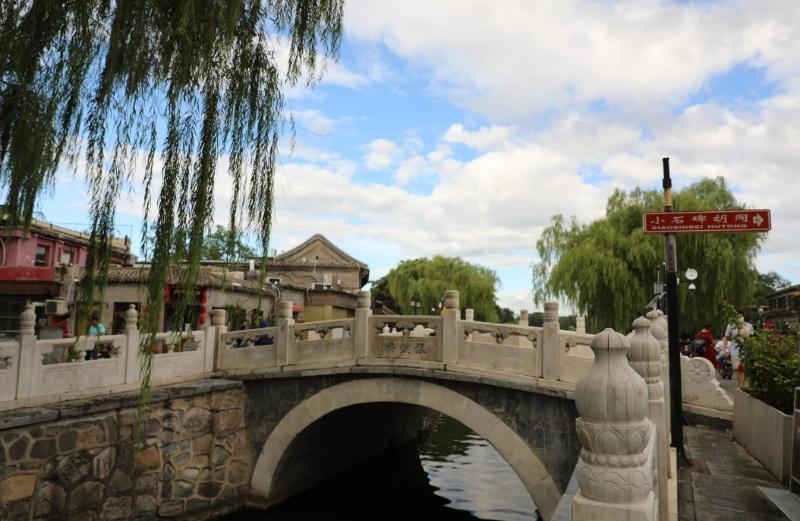Exploring Traditional Courtyards in Shichahai
Shichahai is located in the northwest corner within the Second Ring Road. In the 13th century during the Yuan Dynasty, it was still a vast body of water. In the early Ming Dynasty, the basin evolved into three reservoirs: West Lake, Back Sea, and Front Sea. Due to its beautiful scenery and proximity to the palace, nobles often frequented the area. They built residences and gardens, some of which are still well-preserved today, earning recognition as the best-preserved folk relics in Beijing.
Best Time to Visit: Each season has its unique charm, with lotus flowers in summer and ice skating in winter. There's cultural allure year-round, but overall, September and October, with their cool breezes, are recommended for travel.

Reference : Shichahai: History, Scenery, and Culture
Walking Tour:
Starting Point: Shichahai Subway Station, Line 8
Passing Through: City Center Bell and Drum Tower
At the exit, the crimson Drum Tower suddenly appears, reminding us that most of what we encounter will be transient. A few steps north is Yandai Xiejie, leading to Shichahai. There are many Eastern and Western dining options nearby. If you're out in the morning, consider having breakfast here before continuing. Adventurous eaters can try some typical Beijing fried liver at Yao's Liver Shop, located at the southeast corner of the Drum Tower. It's popular among locals, though the service may not match the food.
First Stop: Yandai Xiejie to Yinding Bridge
Yandai Xiejie is one of Beijing's earliest "slanted" streets—Beijing is mostly a grid, with few streets deviating from horizontal or vertical. It's only 300 meters long and was once frequented by bird enthusiasts who loved exotic birds. They were typically smokers, and smoking-related items were the main business of the shops—hence its name. Yandai Xiejie is one of Beijing's oldest commercial and cultural streets.
Today, Yandai Xiejie is home to various merchants showcasing old Beijing handicrafts like embroidered shoes and clothing. If you look closely, interesting things can be found everywhere. Shops on the street often have unique decorations—it's a good idea to slow down and take a stroll here.
In the middle section on the north side of the street is Guangfu Temple, a Taoist temple built in the Ming Dynasty (1459). It was the imperial management institution of Taoism and has been open to the public since 2008.

Second Stop: Yinding Bridge — Back Sea North, West Side
Yinding Bridge may be small, but it has a prestigious lineage. Built in the Ming Dynasty, it has a history of over 500 years. The dreamy scenery of Shichahai has attracted literati and poets for centuries.
The view from Yinding Bridge exudes an Eastern and harmonious calm. The architecture, greenery, mountain views, and water scenes are perfectly balanced, earning it a place among Beijing's eight scenic spots, known as "Yinding Mountain View." Nowadays, this small bridge is often crowded with tourists, and nearby snack stalls may be a bit overpriced and lackluster.
Keep going without crossing. Walking west along the north bank, you'll encounter relatively fewer people. When the weather is good, you might encounter local elders fishing, playing cards, or even swimming. A little further ahead is the final residence of the beloved former First Lady Soong Ching-ling, open for visitation year-round. Along the way is the former noble mansion Chun Prince's Mansion, also known as the North Mansion. Unfortunately, this courtyard mansion now serves as a religious affairs management institution and is no longer open to the public.

Third Stop: Back Sea South Bank — Prince Gong's Mansion
Returning along the south bank, heading east, near the water's edge, on the right are pavilions, gardens, and tea houses. The famous Kong Yiji Restaurant is nearby. They offer food from the Yangtze River Delta. Enjoy lakeside cuisine here, starting with Hui Xiang beans (fennel beans) and Shaoxing wine.
Locals often relax in the Back Sea Park, located a few steps east of the ferry terminal. Passing through Back Sea Park, find Yangfang Hutong, turn right onto Liuyin Street. 400 meters to the south is the most luxurious stop of this tour—Prince Gong's Mansion. Built in the 18th century, it was constructed by the corrupt eunuch Heshen. Prince Gong's Mansion is located on the southwest side of Shichahai, situated on an undisturbed royal landscape avenue, with lush willows. Despite enjoying centuries of prestige, it remains the best-preserved of its kind.
This mansion is divided into residences and gardens. The residences were constructed with the highest quality materials of the time, situated on spacious grounds, composed of multiple courtyards arranged precisely into three rows. Among them is a particularly luxurious building called "Xijinzhai," adorned with exquisite decorations such as intricately carved Chinese walls made of precious nanmu wood, built according to palace standards.
The garden cleverly parallels the residences, also in three sections, with a Western-style stone archway entrance at the center. The central garden features unique rock formations, bat-shaped ponds, long covered pathways, all based on traditional, superstitious, or auspicious homophonic elements. The eastern garden features a theater as its focal point, refurbished to be grand and impressive. In this room, audiences enjoy performances under the blooming wisteria. Other classical Chinese gardens also have distinctive features: winding paths, pavilions, "gardens within gardens," rocks, big trees, and flowing water.
Fourth Stop: Kaorouji Hutong Barbecue
After leaving Prince Gong's Mansion, walk east for 15 minutes, passing by the former residence of scholar Guo Moruo, through Nanguanfang Hutong and Jinyu Hutong, back to Yinyuanbao Bridge. Many quadrangle courtyards line these hutongs, and though they're in the city center, local residents live here, leading a traditional Beijing lifestyle. Kaorouji ("Grilled Meat Season") is the most famous restaurant in Shichahai—if you set out in the morning, it'll be about lunchtime. Kaorouji is located next to Yinyuanbao Bridge and was established in 1848, specializing in traditional Beijing barbecue.
The barbecue uses the finest cuts of Hebei Province's black-headed mutton from west of Zhangjiakou. Typically, only high ribs, tenderloin, and filet steak are chosen. They're thinly sliced with a specially designed long and heavy knife, then seasoned with soy sauce, shrimp paste, fragrant oil, ginger juice, and vinegar, and grilled on the classic Beijing grill along with chopped onions, usually over wood from fruit trees. The meat is repeatedly washed with egg whites during cooking to maintain tenderness and moisture, then served with fresh cilantro chiffonade. The choice of ingredients and technique suppresses the gaminess of the mutton, making the flavor even more delicious.
Fifth Stop: Qianhai, Southeast Bank — Lotus Market
After lunch, head south along the coastline towards the Lotus Market, passing by the Hoja Temple and Jinding Bridge. In the appropriate season, typical Eastern lake views, willows, and lotuses will help
you while away the afternoon.
Over a century ago, the Lotus Market was already a favorite leisure spot for Beijingers. Today, it's very popular, especially at night. The bar scene here is a mix of various nightlife experiences.
Sixth Stop: Shichahai Shadow Art Hotel
Shichahai Shadow Art Hotel is located on Songshu Street, adjacent to Prince Gong's Mansion, about a 5-minute walk to the lake. The boutique courtyard design is managed by a Taiwanese company called The One and features a harmonious blend of modern and traditional elements.
Carved on the grand chandelier in the hotel lobby are a pine tree and two cartoons, hinting at the hotel's theme—Chinese shadow art.
Shadow art is a classic folk puppetry, consisting of shadows cast by thinly cut leather figures, accompanied by storytelling, music, and voice-acting. The hotel offers free classes every Monday, Wednesday, and Friday. Tuesday, Thursday, and Friday evenings are performance nights, also free for guests.
Shichahai Shadow Art Hotel has 25 rooms named after character types from traditional shadow plays. The pervasive use of lighting and shadow is the central design theme throughout the hotel. For example, the breakfast area and lounge are separated by doors with specially designed cultural patterns. When the first rays of light shine into the rooms, the patterns' shadows are cast on the walls, adding to the cultural experience.
The Shadow Art Hotel is prepared to host banquets featuring Hakka cuisine and also offers local tourist activities such as rickshaw hutong tours and boat tours with catering.

Question: What is the significance of Yandai Xiejie in Beijing's history?
Answer: Yandai Xiejie is significant in Beijing's history as one of the city's earliest "slanted" streets. Unlike the typical grid layout of Beijing's streets, Yandai Xiejie deviates from the horizontal or vertical direction. It was once frequented by bird enthusiasts and smokers, with smoking-related items being the main business of the shops along the street. Today, it is one of Beijing's oldest commercial and cultural streets, showcasing various merchants offering old Beijing handicrafts.
Question: Can you describe the architecture and features of Prince Gong's Mansion in Shichahai?
Answer: Prince Gong's Mansion, built in the 18th century, is located on the southwest side of Shichahai. It is situated on an undisturbed royal landscape avenue, surrounded by lush willows. The mansion is divided into residences and gardens, constructed with the highest quality materials of the time. The residences feature multiple courtyards arranged precisely into three rows, with a particularly luxurious building named "Xijinzhai." The garden, also in three sections, includes unique rock formations, bat-shaped ponds, long covered pathways, and a theater as its focal point. Overall, Prince Gong's Mansion is renowned for its well-preserved architecture and extensive grounds, making it a highlight of Shichahai.